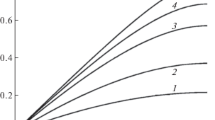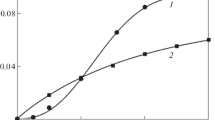Abstract
Martensitic inelasticity effects in shape memory alloys are described by a version of the plastic flow theory with isotropic and translational hardening, where the maximum value of the phase-structure strain intensity is taken for the isotropic hardening parameter. We show that, in the framework of this model, the entire inelastic deformation process is generally divided into the stages of purely translational and combined hardening and the tangent modulus is discontinuous on the interface between these stages.
Similar content being viewed by others
References
G. B. Kurdyumov and L. G. Khandros, “On the “Thermoelastic” Equilibrium on Martensitic Transformations,” Dokl. Akad. Nauk SSSR 66(2), 211–214 (1949) [Ukr. J. Phys. (Engl. Transl.) 53 Spec. Issue, 89–92 (2008)].
V. A. Likhachev, S. L. Kuz’min, and Z. P. Kamentseva, Shape Memory Effect (Izd-vo LGU, Leningrad, 1987) [in Russian].
Y. Liu, Z. Xie, J. van Humbeeck, and L. Delaey, “Some Results on the Detwinning Process in NiTi Shape Memory Alloys,” Scripta Mater. 41(12), 1273–1281 (1999).
P. Thamburaja, “Constitutive Equations for Martensitic Reorientation and Detwinning in Shape-Memory Alloys,” J. Mech. Phys. Solids 53, 825–856 (2005).
Y. Liu and H. Xiang, “Apparent Modulus of Elasticity of Near-Equiatomic NiTi,” J. Alloys Compounds 270, 154–159 (1998).
S. A. Abdrakhmanov and K. D. Dyushkeev, Laws of Behavior of Shape-Memory Alloys under Thermal Force Action (Ilim, Bishkek, 1992) [in Russian].
Y. Liu, J. van Humbeeck, R. Stalmans, and L. Delaey, “Some Aspects of the Properties of TiNi Shape Memory Alloy,” J. Alloys Compounds 247, 115–121 (1997).
Y. Liu, Z. Xie, J. van Humbeeck, and L. Delaey, “Asymmetry of Stress-Strain State Curves under Tension and Compression for NiTi Shape Memory Alloys,” Acta Mater. 46(12), 4325–4338 (1998).
V. A. Lomakin, “Mechanics of Media with Stress-State-Dependent Properties,” Fiz. Mezomekh. 10(5), 41–52 (2007).
V. A. Lomakin, “Constitutive Models of Mechanical Behavior of Media with Stress-State-Dependent Material Properties,” Adv. Struct. Mater. 7, 339–350 (2011).
J. A. Shaw and S. Kyriakides, “Thermomechanical Aspect of TiNi,” J. Mech. Phys. Solids 43(8), 1243–1281 (1995).
G. Airoldi, T. Ranucci, G. Riva, and A. Sciacca, “The Two-Way Memory Effect by the Pre-Strain Training Method in a 50Ti40Ni10Cu (at %) Alloy,” Scripta Mater. 34(2), 287–292 (1996).
A. A. Movchan, S. A. Kazarina, Tant Zin Aung, “Analog of Theory of Plasticity for Describing Deformations of Shape Memory Alloys under Phase and Structure Transformations,” Deform. Razrush. Mater., No. 9, 2–6 (2009).
A. A. Movchan and S. A. Kazarina, “Shape Memory Materials as an Object of Deformable Solid Mechanics: Experimental Studies, Constitutive Relations, Solution of Boundary-Value Problems,” Fiz. Mezomekh. 15(1), 105–116 (2012).
A. A. Movchan, I. A. Movchan, and L. G. Sil’chenko, “Micromechanical Model of Nonlinear Deformation of Shape Memory Alloys in Phase and Structure Transformations,” Izv. Akad. Nauk. Mekh. Tverd. Tela, No. 3, 118–130 (2010) [Mech. Solids (Engl. Transl.) 45 (3), 406–416 (2010)].
Z. P. Kamentseva, S. L. Kuz’min, and V. A. Likhachev, “Strain Hardening of Titanium Nickelide,” Probl. Prochn., No. 9, 87–91 (1980) [Strength of Materials (Engl. Transl.) 12 (9), 1151–1155 (1980)].
A. Bertram, “Thermo-Mechanical Constitutive Equations for the Description of Shape Memory Effect in Alloys,” Nuclear Engng Des. 74(2), 173–182 (1982).
A. E. Volkov, V. A. Likhachev, and A. I. Rozov, “Mechanics of Plastic Materials with Phase Transitions,” Vestnik Leningrad. Univ. Mat. Mekh. Astronom., No. 19 (4), 30–37 (1984) [Vestnik Leningrad Univ. Math. (Engl. Transl.)].
M. A. Savi, A. Paiva, A. P. Baeta-Neves, and P. M. C. L. Pacheco, “Phenomenological Modeling and Numerical Simulation of Shape Memory Alloys: A Thermo-Plastic-Phase Transformation Coupled Model,” J. Int. Mater. Syst. Struct. 13(5), 261–273 (2002).
A. F. Saleeb, S. A. Pabudala, and A. Kumar, “A Multi-Axial, Multi-Mechanism Based Constitutive Model for the Comprehensive Representation of the Evolutionary Response of SMA’s under General Thermomechanical Loading Condition.” Int. J. Plasticity 27(5), 655–687 (2011).
J. Arghavani, F. Auricchio, and R. Naghdabasi, “A Finite Strain Kinematic Hardening Constitutive Model Based on Hencky Strain: General Framework, Solution Algorithm, and Application to Shape Memory Alloys,” Int. J. Plasticity 27(6), 940–961 (2011).
Yu. I. Kadashevich and V. V. Novozhilov, “The Theory of Plasticity which Takes into Account the Bauschinger Effect,” Dokl. Akad. Nauk SSSR 117(4), 586–588 (1957).
Yu. I. Kadashevich and V. V. Novozhilov, “The Theory of Plasticity which Takes into Account Residual Microstresses,” Prikl. Mat. Mekh. 22(1), 78–89 (1958) [J. Appl. Math. Mech. (Engl. Transl.) 22 (1), 104–118 (1958)].
R. A. Aratyunyan and A. A. Vakylenko, “On Multiple Loading of Elastoplastic Medium,” Izv. Akad. Nauk SSSR. Mekh., No. 4, 53–61 (1965).
A. A. Movchan, S. A. Kazarina, I. V. Mishustin, and I. A. Movchan, “Thermodynamical Justification of the Model of Nonlinear Deformation of Shape Memory Alloys in Phase and Structure Transformations,” Deform. Razrush. Mater., No. 8, 2–9 (2009).
A. A. Movchan, L. G. Silchenko, and T. L. Silchenko, “Taking Account of the Martensite Inelasticity in the Reverse Phase Transformation in Shape Memory Alloys,” Izv.Akad. Nauk. Mekh. Tverd. Tela, No. 2, 44–56 (2011) [Mech. Solids (Engl. Transl.) 46 (2), 194–203 (2011)].
R. J. Wasilevski, “Martensitic Transformation and Fatigue Strength in TiNi,” Scripta Metal. 5(3), 207–211 (1974).
K. N. Melton and O. Mercier, “Fatigue of TiNi Thermoelastic Martensites,” Acta Metall. 27(1), 137–144 (1979).
Author information
Authors and Affiliations
Corresponding author
Additional information
Original Russian Text © I.V. Mishustin, A.A. Movchan, 2015, published in Izvestiya Akademii Nauk. Mekhanika Tverdogo Tela, 2015, No. 2, pp. 78–95.
About this article
Cite this article
Mishustin, I.V., Movchan, A.A. Analog of the plastic flow theory for describing martensitic inelastic strains in shape memory alloys. Mech. Solids 50, 176–190 (2015). https://doi.org/10.3103/S0025654415020077
Received:
Published:
Issue Date:
DOI: https://doi.org/10.3103/S0025654415020077




